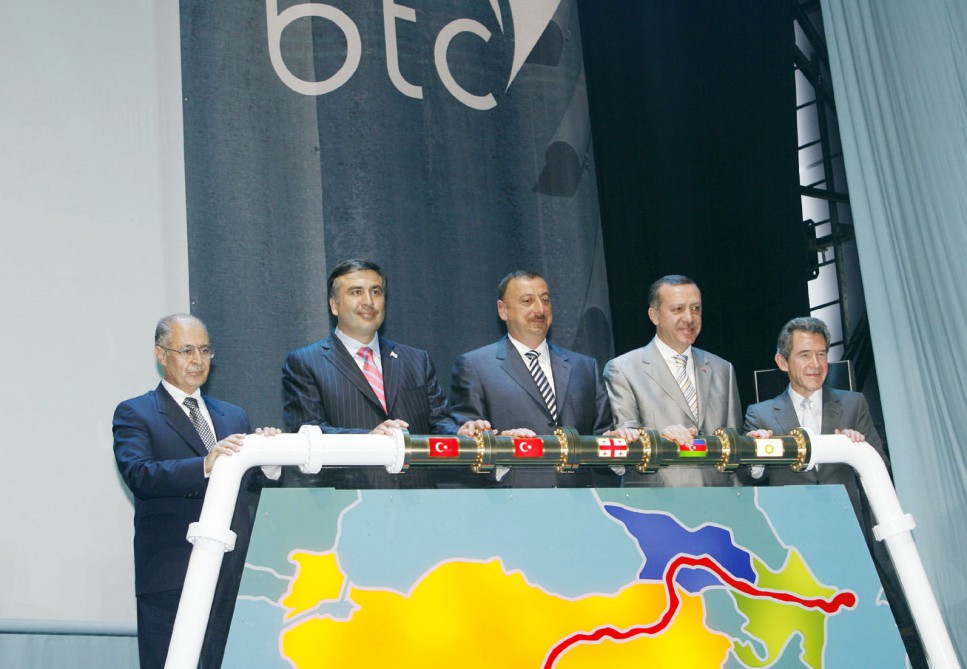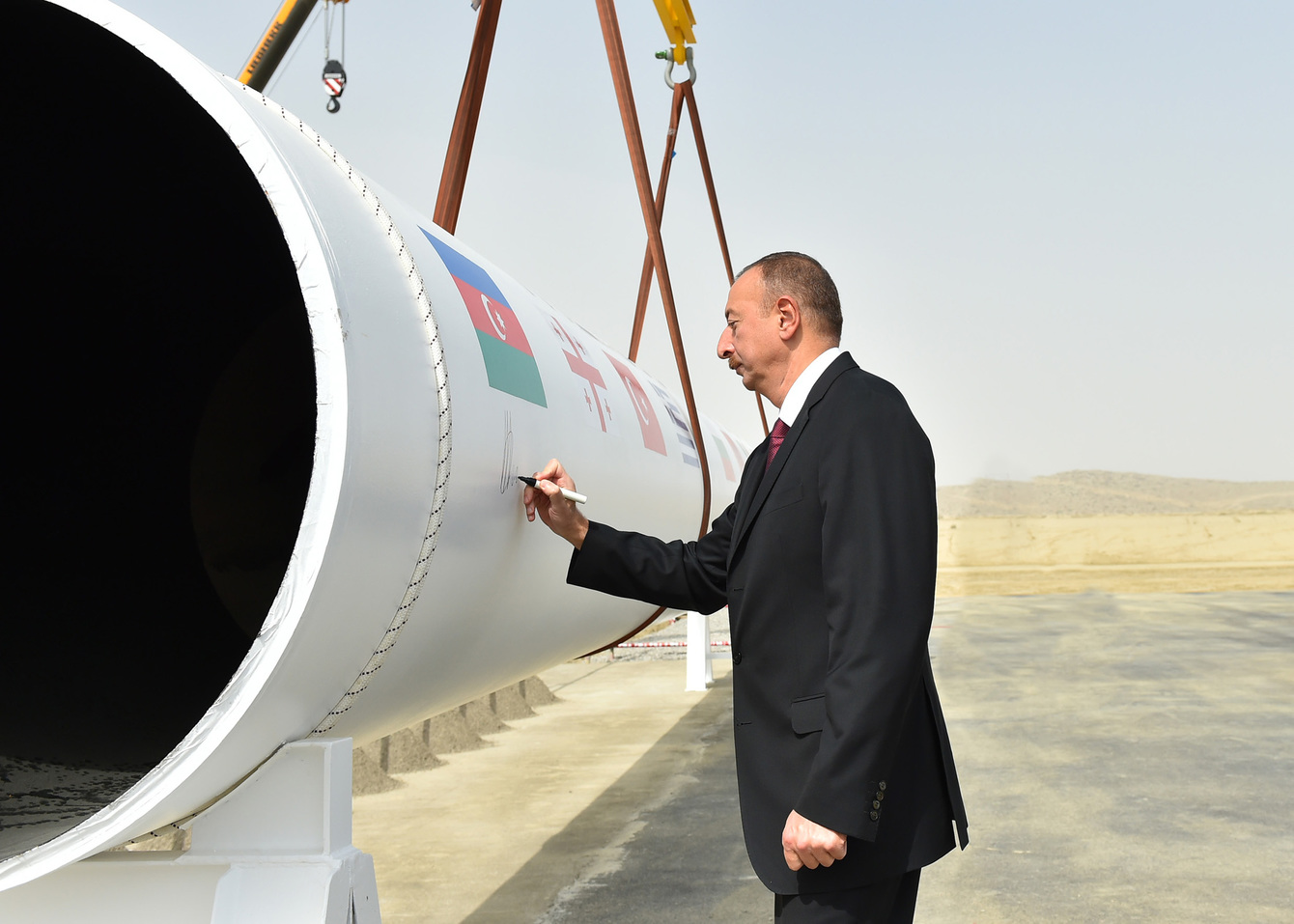THE MAIN TRANSPORT ROUTES OF ENERGY RESOURCES
 The way to transport energy resources to the global markets was one of the major trends of Azerbaijan`s new oil strategy. The establishment of the alternative routes for transportation of oil was another important element in the oil strategy of the national leader. The alternativeness of the oil transportation not only put an end to the economic dependence of Azerbaijan on any other state but also corresponded to the national interests of the country. Currently, Azerbaijan's energy resources are exported to the world market via several routes. These are the Baku-Novorossiysk, Baku-Supsa, Baku-Tbilisi-Ceyhan oil pipelines, Southern Caucasus pipeline which is a part of the Southern Gas Corridor project, TANAP (Trans-Anatolian Natural Gas Pipeline), and TAP (Trans Adriatic Pipeline) gas pipelines under the Southern Gas Corridor project.
The way to transport energy resources to the global markets was one of the major trends of Azerbaijan`s new oil strategy. The establishment of the alternative routes for transportation of oil was another important element in the oil strategy of the national leader. The alternativeness of the oil transportation not only put an end to the economic dependence of Azerbaijan on any other state but also corresponded to the national interests of the country. Currently, Azerbaijan's energy resources are exported to the world market via several routes. These are the Baku-Novorossiysk, Baku-Supsa, Baku-Tbilisi-Ceyhan oil pipelines, Southern Caucasus pipeline which is a part of the Southern Gas Corridor project, TANAP (Trans-Anatolian Natural Gas Pipeline), and TAP (Trans Adriatic Pipeline) gas pipelines under the Southern Gas Corridor project.
According to the new energy strategy, a number of successful projects have been signed over transporting Azerbaijan's energy potential to world markets. Azerbaijan became the potential exporter of gas in the world during the last years and enriched the region and Europe`s energy map. Azerbaijan is an initiator and active participant in a number of global energy and transport projects that acts independent economic country. Azerbaijan ensured its energy security with its rich hydrocarbon resources. On the other hand, Azerbaijan has been making significant contributions to Europe's energy security for many years.
Our Republic has significantly strengthened its role in the world energy market as a result of the accurate transportation strategy of energy resources implemented today.
Baku-Novorossiysk
A treaty was signed in Moscow on February 18, 1996, about the transportation of Azerbaijani oil through the territory of Russia to the Black Sea port of Novorossiysk. The trilateral contract concluded between the International Operating Company of Azerbaijan, SOCAR and Transneft reflected all legal and technical issues stipulating for the transportation of oil to the port of Novorossiysk. In this agreement, Russia confessed by paragraph 2 of the said contract that it is not the owner of the Azerbaijan oil. The owner of Azerbaijani oil is the producer of it. This event is one of the crucial achievements of Azerbaijan`s new oil strategy for that period. According to the agreement`s primary conditions, Azerbaijani oil transported to the world market via northern pipeline on October 25, 1997. Baku-Novorossiysk pipeline extends to 1330 kilometers with 231 kilometers in Azerbaijan. It is 720 mm in diameter. The annual capacity of the pipeline is 6.1 million tons.
Baku-Supsa
President of Azerbaijan Heydar Aliyev and President of Georgia E. Shevardnadze agreed on the establishment of the Baku-Supsa pipeline in Tbilisi March 8, 1996. The trilateral contracts signed between the International Operating Company of Azerbaijan, SOCAR, and Georgia stipulated for the first Azeri oil from Azeri, Chirag, and Guneshli fields to be transported by the Baku-Supsa oil pipeline.
The first Azeri oil started to be transported by the Baku-Supsa pipeline on April 17, 1999. The major advantage of the pipeline was the transportation of net Azeri light oil to the global markets. At the same time, the lower prices of the transportation of oil to Supsa and Novorossiysk were also the positive feature of the route. The Baku-Supsa pipeline extends to 837 kilometers to the west and 530 mm in diameter. The annual capacity of the pipeline is 5.1 million tons.
Baku-Tbilisi-Ceyhan oil pipeline
The implementation of a strategically important project as the Baku-Tbilisi-Ceyhan main export pipeline was a very important event in terms of ensuring the transportation of oil to the global markets due to the protection of the national interests of Azerbaijan. İt is also important for the development of large-scale international economic cooperation, and the increase of oil production in the country.
First, the exact idea of the establishment of the main oil pipeline was determined at the Trabzon meeting of the presidents of Azerbaijan, Georgia, and Turkey on April 26, 1998. The three Presidents announced openly that Baku-Tbilisi-Ceyhan must the head export pipeline thus declaring the political decision on the implementation of the project. The first agreement on the said project was reached by the signing of the Ankara declaration supporting the establishment of the head export pipeline with the route Baku-Tbilisi-Ceyhan by the Presidents of Azerbaijan, Turkey, Georgia, Kazakhstan, and Uzbekistan and the US Energy Minister in Ankara on October 29, 1998.
As a result of all that a contract on the transportation of crude oil by Baku-Tbilisi-Ceyhan pipeline via Azerbaijan, Georgia, and Turkey was signed during the OSCE summit at Chyraghan Palace of Istanbul on November 18, 1999. It was signed by H. Aliyev, E. Shevardnadze, and S. Demirel. The Istanbul Declaration was signed between Azerbaijan (Heydar Aliyev), Turkey S. Demirel), Georgia (E. Shevardnadze), Kazakhstan (Nursultan Nazarbayev), and Turkmenistan (S. Niyazov) under the witness of the USA (B. Clinton) to support the Baku-Tbilisi-Ceyhan pipeline and to attract Kazakhstan and Turkmenistan to the project. The construction of the Baku-Tbilisi-Ceyhan pipeline was initiated on the Sangachal terminal on September 18, 2002, as the logical continuation of this process. The ceremony was attended by three President-President of Azerbaijan Heydar Aliyev, President of Georgia E. Shevardnadze, and President of Turkey A. N. Sezer, and US representatives for the Caspian issues S. Mann. Thus, Baku-Tbilisi-Ceyhan, the major achievement of the new oil strategy worked out by national leader Heydar Aliyev, was on the point of coming to life.
The Azeri section of the BTC pipeline joined Georgian one in October of 2004. On May 28, 2006, Azerbaijani oil reached the port of Ceyhan, where the first tanker loaded with oil departed on July 4. On July 13, 2006, the opening of the Heydar Aliyev Baku-Tbilisi-Ceyhan main export pipeline which is the largest energy project of the 21st century, was held in Ceyhan, Turkey.
Almost $ 4 billion has been spent on the construction of the 1,774-kilometer line from the Sangachal terminal to the Ceyhan terminal on Turkey's Mediterranean coast. The operator of the project is BP company. The project comprises the following shareholders: BP (30.1%), SOCAR (25%), UNOCAL (8.9%), Statoil (8.71%), TRAO (6.53%), ENI (5%), TotalFinaElf (5%), Itochu (3.4%), Inpex (2.5%), ConocoPhillips (2.5%) and Amerada Hess (2.36%).
The Baku-Tbilisi-Ceyhan pipeline can transport 60 million tons of oil a year. More than 2.7 billion barrels of crude oil have been transported via the pipeline since the Baku-Tbilisi-Ceyhan was put into operation. The Baku-Tbilisi-Ceyhan pipeline has great importance for Azerbaijan, Georgia, Turkey, and the region as a whole, Europe, and the world in general in terms of its great economic, political, and energy security.
Southern Caucasus Pipeline

The great Shahdeniz gas condensate field was discovered in 1999 as the result of the successful conduction of the new oil strategy, the high level of investments in the oil industry, and the application of modern technique and technology in the oil operations. The Shahdeniz field and BTC pipeline projects comprise SOCAR (Azerbaijan)-10%, Statoil (Norway)-25.5%, BP (Great Brotain), TotalFinaElf (France)-10%, LukAcip (Russia Italy)-10%), OLIK (Iran)-10%, TPAO (Turkey)-9%. The discovery of the Shahdeniz gas field created conditions for the development of gas industry in Azerbaijan and the transformation of the country into one exporting gas along with oil in the 21st century.
During the official visit of the President of Azerbaijan Heydar Aliyev to Turkey, Azerbaijan and Turkey signed a contract on the sales and purchase of the natural gas of Azerbaijan on March 12, 2001. Azerbaijan and Georgia signed a contract on the transit, sales, and transportation of natural gas via Georgia was signed on September 29 of 2001.
Natural gas from the Shah Deniz gas condensate field in the Azerbaijani sector of the Caspian Sea entered the Turkish gas pipeline system via the Baku-Tbilisi-Erzurum gas pipeline in July 3, 2007.
The Southern Caucasus pipeline is 690 km long and it has a capacity to transport up to 20 billion cubic meters of gas. The pipeline is on the same route as the Baku-Tbilisi-Ceyhan (BTC) crude oil pipeline in Azerbaijan and Georgia until the Turkish border and is connected to Turkey's gas distribution system.
Baku-Tbilisi-Erzurum pipeline made Azerbaijan a gas exporter for the first time after its operation. Azerbaijani gas started to export to Georgia and Turkey. At the same time, this process paved a way for the foundation of the Southern Gas Corridor and the development of the Shah Deniz field.
In order to ensure the operation of the Southern Gas Corridor, large-scale works started on the Southern Caucasus Pipeline (SCP).
The expansion of the South Caucasus Pipeline is part of a full-scale development project for the Shah Deniz field. The construction of a new pipeline in Azerbaijan and the construction of two new compressor stations in Georgia are included in this expansion. With this pipeline, more than 20 billion cubic meters of gas exported per year, and the volume of gas exportation tripled.
Southern Gas Corridor

On the 20th anniversary of the Contract of the Century at the Sangachal terminal in 2014, the basis of the Southern Gas Corridor was a logical continuation of a successful 20-year energy policy. This project will be twice longer as Baku-Tbilisi-Ceyhan and an estimated $ 45 billion. This project will not only contribute to Azerbaijan by bringing additional dividends but also, develop the country`s economy more.
The Southern Gas Corridor which is an important factor in the energy security of Europe, will broaden multilateral partnership and accelerate the process of international cooperation. Firstly, Georgia, Turkey, Greece, Bulgaria, Albania, Italy, and later Montenegro, Croatia, and other countries will be able to join the Southern Gas Corridor.
Works on four elements for the implementation of the Southern Gas Corridor are continuing successfully. Currently, four elements of the corridor – Shah Deniz – 2 fields, the expansion of the Southern Caucasus pipeline, works on TANAP and TAP projects are completed. The official opening ceremony of the Southern Gas Corridor took place at the Sangachal terminal in Baku on May 29, 2018.

TANAP is an important part of the Southern Gas Corridor. On June 26, 2012, an intergovernmental agreement signed between the Government of the Republic of Turkey and the Government of the Republic of Azerbaijan concerning the Trans-Anatolian Natural Gas Pipeline System. Both governments` legislatures ratified the agreement.
On June 12, 2018, the TANAP gas pipeline was put into operation in Turkey`s Eskisehir city.
Trans-Anatolian Gas Pipeline has great economic and political importance because, this pipeline does not only supply the gas which is produced under the Shah Deniz project, but also, natural gas from other fields of Azerbaijan to the world market.
Trans-Anatolian Gas Pipeline transports natural gas from the eastern border to Turkey's western border and ensures stable transit throughout the country. The project connects the expanded South Caucasus Pipeline which begins in Azerbaijan and connects with several European Union pipelines. The implemented project`s cost over the 5 years is $ 8 billion (US dollar).

TANAP`s total length is 1,850 kilometers and 18 kilometers of this length is underwater section. The diameter of the pipeline is 1.4 meters. It is expected that the capacity of the pipeline will reach 31 billion cubic meters in 2026. The shareholders of TANAP in this project are as follows: "Southern Gas Corridor" Closed Joint-Stock Company (CJSC) – 58 percent, Botas – 30 percent, and BP – 12 percent.
Trans-Adriatic Pipeline (TAP) project ensures the transportation of gas from the Caspian region via southern Greece, Albania, and the Adriatic Sea to southern Italy and from there to Western Europe. The TAP project is a continuation of the SCP and TANAP, ensures the transportation of gas from Shah Deniz-2 via Greece and Albania, across the Adriatic Sea to southern Italy, and from there to Western Europe. The TAP pipeline starts in Kipoi, Greece, on the border with Turkey. From here, the TAP pipeline crosses the territory of Greece and Albania and Its direction from east to west follows the Adriatic sea and reaches the coast of Puglia in Italy. This project creates great opportunities for the delivery of Azerbaijani gas to major European markets such as Italy, Germany, France, Great Britain, Switzerland, and Austria.
The annual transmission capacity of the TAP is 10 billion cubic meters it is expected to increase to 20 billion cubic meters in the future.
Shares of TAP shareholders in the project - BP (20 percent), SOCAR (20 percent), Snam S.p.A. (20 percent), Fluxys (19 percent), Enagás (16 percent), and Axpo (5 percent).



